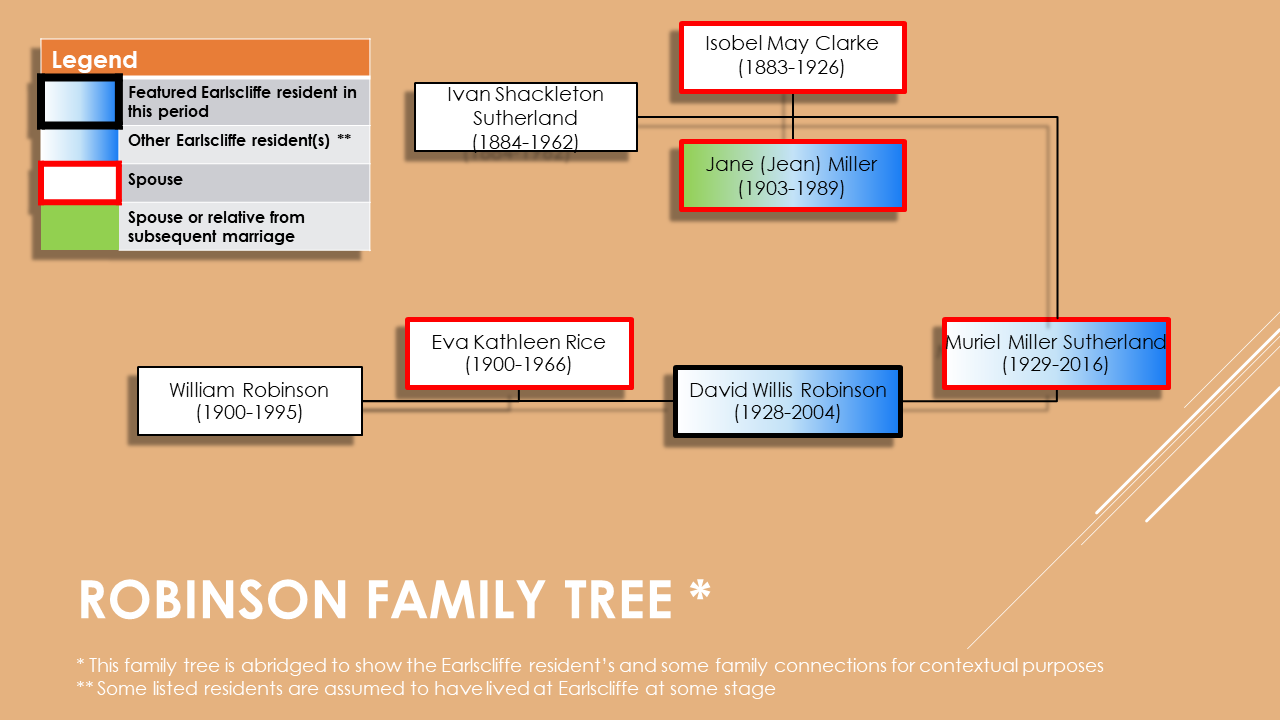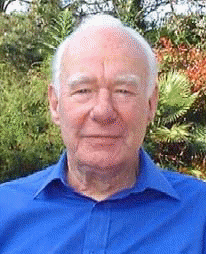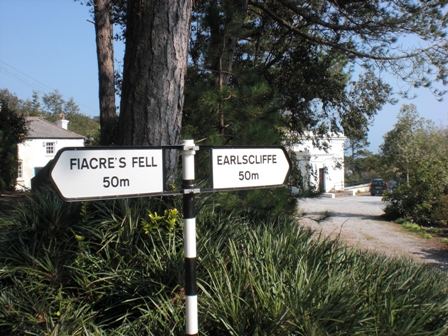History of the House / 1969 to today - Robinson & Foley family
Previous / Next: 1961 to 1969 - Knowles
Earlscliffe residents 1969 to today
The next people to own Earlscliffe were David and Muriel Robinson.
David and Muriel Robinson
Family History

David Robinson

David Robinson was born in Belfast in 1928.
His
father was a small-scale builder and, as times were hard during the
1930s, his father augmented his income by selling bedding plants in
the
Horticultural experience
David's earliest horticultural memory was as a youngster around 10 years old. His father asked him to remove groundsel seedlings from beds of ornamental Bellis perennis before they went to market and he remembered marvelling at how quickly this weed could produce flowers and its efficient method of seed dispersal.
In his mid teens, David spent summer holidays on a vegetable farm near Comber, Co. Down weeding parsley destined for Glasgow. For weeks he crawled along drills with hessian sacks around his knees carefully removing groundsel, redshank, fat hen and other annuals from parsley seedlings. These experiences gave him an early insight into the key role that weeds play in nearly all aspects of horticulture and the drudgery involved in manual control. It also gave him a hatred of weeds, which persisted his whole life.
After David graduated from Reading University with a degree in horticulture, his first job was as Horticultural Adviser in South Down.
Marriage to Muriel Miller Sutherland
In 1953, David had an agricultural colleague who had recently been rejected by his girlfriend but was striving for reconciliation. When the colleague's ex girlfriend’s mother asked him for advice on her non-fruiting apple tree, the colleague turned to David Robinson for help. Clinging to the belief that solving the mother’s apple problem would help his case with the daughter, the colleague and David paid them a visit.
As David recalled:
It was a fruitful advisory meeting although not as planned as I failed to impress the mother [Jean Sutherland]. However I made a much better impression on the daughter [Muriel Sutherland] and two years later we married.
-David Robinson, as quoted in "Plants that changed my life", The Horticulturist, Autumn 2003 [1]
David and Muriel subsequently went on to have two children, Karen and Ivan.
Study at Cornell University in New York State
David's research into the many chemical weed control tools that were becoming available at the time established him as an expert in this field. However, he had,at the time, no training in research methods or statistical analysis and felt that he was in a job for which he was inadequately trained. He decided to do something about this.
As David later wrote:
I knew early in 1954 that the well endowed W.K. Kellogg Foundation was giving grants to people in Britain to provide further training in the USA for agricultural graduates. I happened to be in London in March 1954 and by pure chance I passed by the headquarters of the Foundation. I still don’t know what gave me the courage but I walked in, asked to see the Director (without an appointment) and told him I wanted a Kellogg Foundation Grant to study at Cornell University in New York State for a year.
At the time I worked for the Ministry of Agriculture in Northern Ireland, a most bureaucratic organisation, and when I returned all hell was let loose for the Ministry felt (understandably) that they and they alone should decide who would benefit from Kellogg grants.
Anyway I was released for a year and spent 1954/55 in the States where I learned a great deal about research and plants. The US had not suffered from the War the way Europe had and it was an exhilarating time.
-David Robinson, lecture to the Howth Peninsula Society, September 1998 [2]
Move to the South of Ireland
When David took up a position at the recently established Loughgall Horticultural Centre in County Armagh in the North of Ireland in 1953, he was asked to carry out applied research on soft fruits. He evaluated cultivars, conducted nutritional trials but the main thrust of his work was on weed control.
Aided by a steady stream of new herbicides, David's work in Northern Ireland made rapid progress and the weed problem in strawberries and other crops greatly diminished.
In February 1959, he accepted an invitation from John Daly, Horticultural Instructor in Co. Wexford, in the South of Ireland to give a lecture on weed control in strawberries. At that time there was little contact at official level between Northern Ireland and the Republic and on his first expedition to the far south of the country, he had no idea what to expect.
David was impressed with the enthusiasm of the over 300 growers who attended the lecture and he could see that growing conditions in the south east of the island were better than they were further north.
Invitations to lecture on strawberries in other parts of the Republic followed, so his work with this crop gave him experience of parts of Ireland that he would not otherwise have had.
When he was offered a position at Kinsealy Research Centre, Agricultural Research Institute (now Teagasc), in Dublin in October 1963, the decision to leave Northern Ireland was the most difficult he had made. His work in the North was going well, he had a great bunch of colleagues, he had just obtained a Fulbright Grant to spend a sabbatical in California, and the Republic of Ireland then was a very different country from what it is today.
Nevertheless the new job in the south of Ireland was challenging and he eventually took up the position in Dublin in May 1964. David later said:
There was, of course, no truth in the story circulated by my facetious former colleagues at Loughgall that I was obliged to move on to fresh fields as I had contaminated so much land in the north with herbicides.
-David Robinson, as quoted in "Plants that changed my life", The Horticulturist, Autumn 2003 [1]
The job at Kinsealy enabled David to perform more research in his chosen field and he remained in this post for almost 25 years (1964-88).
Move to Dublin
When David accepted the post at Kinsealy Research Centre in 1964, he initially moved to a new housing estate called Ard na Mara in Malahide, Co. Dublin with Muriel and their young family.
Two years before their move down south, Muriel's father, Ivan Shackleton Sutherland, had died. Now living on her own, Muriel's widowed mother, Jean Sutherland (née Miller), a retired doctor who had previously worked as a GP in the North of Ireland, decided to move down to Dublin with her daughter. She also bought a house in the Ard na Mara estate.
The house that David Robinson bought was one of the first to be built in the Ard na Mara estate, and David insisted that the plan for the house was changed. Instead of the the main living room looking out into the road, he got the builder to turn the house plans180 degrees and have the living room facing the beautiful garden he was going to create at the back of the house!
David soon set about developing this wonderful garden, exploiting his increasing knowledge of tender plants that would survive in this part of the world from all five continents, and using herbicides to manage the weeds. However, he later stated:
One of the hazards of using herbicides in ornamental plantings is that gardening becomes so easy that many people want to garden on a larger scale.
-David Robinson, as quoted in "Plants that changed my life", The Horticulturist, Autumn 2003 [1]
It didn't take long for David to outgrow his garden at Ard na Mara and for him to start to look for a bigger challenge.
Move to Earlscliffe
In 1969, Olga Knowles put Earlscliffe up for sale. At auction, the house was expected to sell quickly and for a large amount of money. However, this was the late 1960s, and big houses with labour intensive gardens were not that popular.
This was fortunate for David and Muriel Robinson who had decided that this was the type of challenge they needed. As David said:
The labour intensive garden [at Earlscliffe] had been carefully manicured by two full-time gardeners and it seemed inevitable that the selling price of the property would be well beyond our means. Fortunately, those were the swinging sixties before gardening had become popular in Ireland and the immaculate garden and potential cost of future maintenance frightened off would-be purchasers. Consequently the house, despite its superb coastal location, failed to reach its reserve at auction. I knew that with herbicides as allies a shrub garden could be easily managed without outside help, basically in the same way as a blackcurrant plantation, and so we were able to buy the property at a low price.
-David Robinson, as quoted in "Plants that changed my life", The Horticulturist, Autumn 2003 [1]
David, Muriel and family, including Muriel's mother, Jean Sutherland, moved into Earlscliffe in 1969.
For a discussion of how the Robinsons coped with the management of the large garden at Earlscliffe see:
Baron's Brae
In 1987, when their children had left home and Earlscliffe had became too big for them, David and Muriel Robinson built a smaller house in the grounds of Earlscliffe in what was previously an orchard. They then rented out Earlscliffe house and the adjoining cottage.
David and Muriel named the smaller house “Baron’s Brae”. This was because, in line with it's small size, a Baron is less than an Earl, and a Brae is a small cliff!
Although they rented out Earlscliffe, they continued to manage the 7-acre (28,000 m2) gardens themselves, and expanded the garden even further by purchasing some adjoining vacant land which was zoned for garden use only.
By 1988, David had retired from his post at Kinsealy allowing him to spend even more time and energy in experimenting with growing tender plants, developing his garden, and allowing organised visits to view his handiwork.
Additional Earlscliffe residents
Since the 1970s there have been many additional people who rented and lived at Earlscliffe or the adjacent cottage/mews. The following is a list of a few of them:
- Bob and Marie Fannin
- Wolf Hilbertz and Uschi Rommerskirchen-Hilbertz
- Tony and Margot Francis
- Bríd and Patrick Sullivan
- Tom and Angela Kinlin and children Caroline, Kate and Chris
 Fiacre's
Fell
Fiacre's
Fell
David Robinson's daughter, Karen, and her husband David Foley moved back to Earlscliffe at the end of 1993. They initially lived in the adjoining cottage and subsequently built a house adjacent to Earlscliffe, and on the same grounds.
They called this new house Fiacre's Fell. They gave it this name partly because St. Fiacre is the patron saint of gardening, and a Fell is a sort of hillside.
However, the main reason they chose that name was that 'Fiacre's Fell' is an anagram of Earlscliffe!
Earlscliffe garden today - the Foley family
Earlscliffe House is now owned by David and Muriel's daughter, Karen, and the garden is managed with the help of Karen's husband, David Foley, and their family, plus additional specialist professional help where required.
• •
List of Earlscliffe Residents
References
- [1] "Plants that changed my life", David Robinson, The Horticulturist, Volume 12 No. 4, Autumn 2003.
- [2] Lecture given by David Robinson to the Howth Peninsula Society, September 1998
This page was last updated on 27-Jul-2023 .
